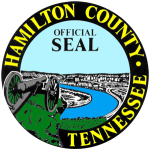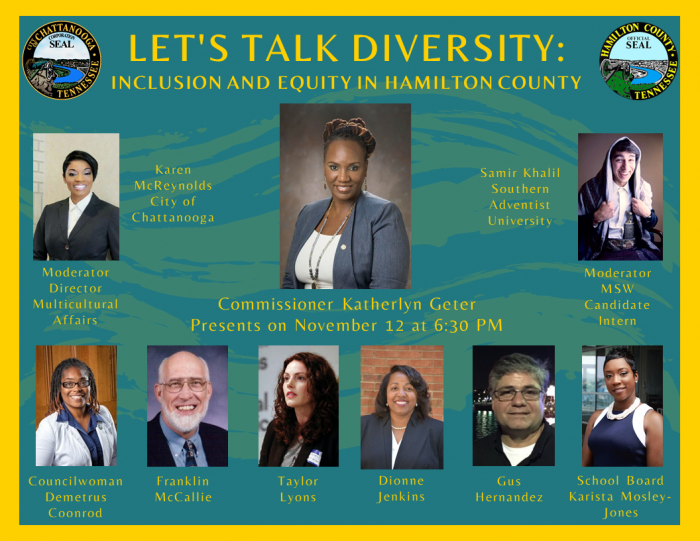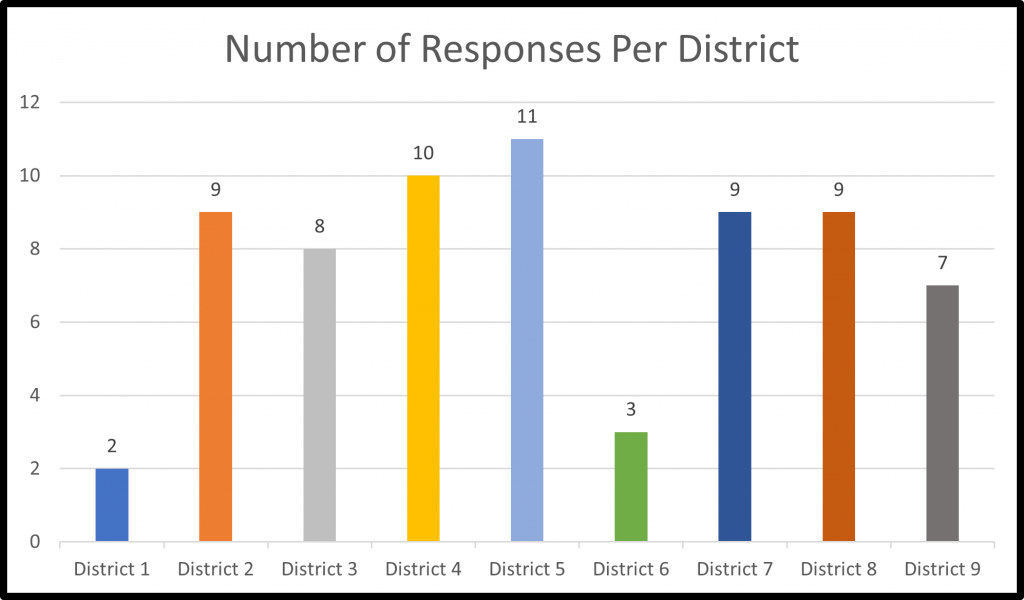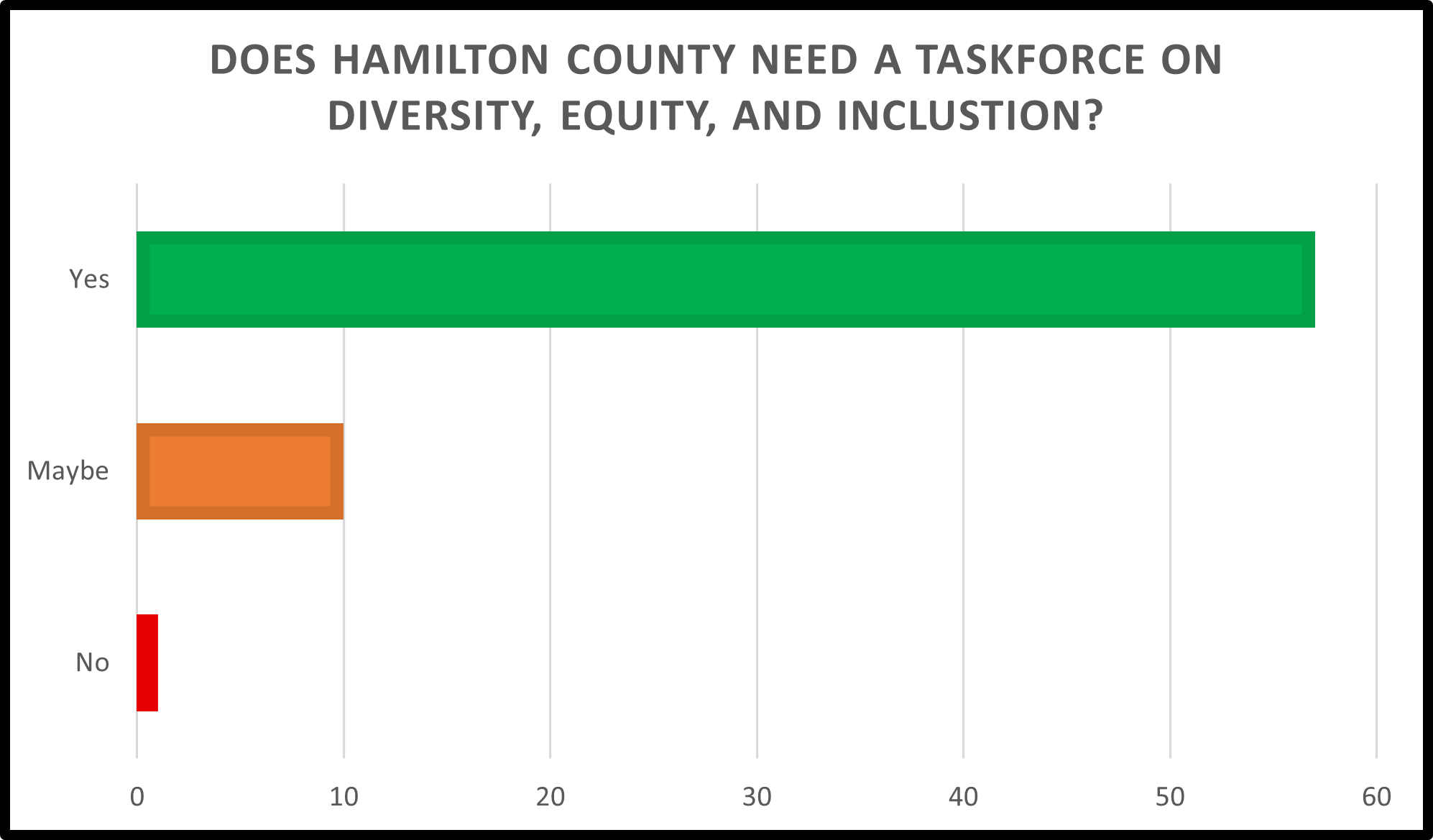The Diversity Taskforce
Introduction
The Diversity Taskforce started out as an initiative created by Commissioner Geter of District 5 of Hamilton County. As the Chair of the Diversity and Equity Committee, she felt that it was her role to start the changes needed towards equity and inclusion and she wanted us to work together to develop this further. This project has been a year-long initiative with members from multidisciplinary backgrounds and organizations working together towards the shared goal. We had members from religious organizations, civil rights groups, private businesses, local government, and citizens who were able to collaborate on this project.
What Social Issue Has Been Addressed and Why?
The social issue that the Diversity Taskforce really aimed to address was discrimination and the lack of inclusivity in Hamilton County. According to Statistical Atlas, there are approximately 251 thousand people in Hamilton County that are white, with 69.5 thousand who are black, 16.8 thousand are Hispanic, 6,925 are Asian, while another 6,750 are mixed-race or categorized are other race1. These numbers are important to understand since they help to show how the population of Hamilton County is spread out. However, according to a report published by the Equal Employment Opportunity (EEO) Office for Hamilton County in 2017, there is a significant gap between women and minorities being hired in a majority of the positions available2. To view a copy of the EEO report, please click here.
As mentioned, while the project was started by Commissioner Geter who felt that  the county was lacking processes to make sure that the county was being diverse, equitable, and inclusive to its constituents, I was able to assist in the planning, research, collaboration, and execution of our goals. The idea originated as a way for members of the community to be able to actively take part in making sure that opportunities are available to all people in the county. The main sponsor for the program was Commissioner Geter’s office itself but was supported by many other organizations in the area such as the Office of Multicultural Affairs for the city of Chattanooga, or the Horton-Keller Center for Traumatic Healing.
the county was lacking processes to make sure that the county was being diverse, equitable, and inclusive to its constituents, I was able to assist in the planning, research, collaboration, and execution of our goals. The idea originated as a way for members of the community to be able to actively take part in making sure that opportunities are available to all people in the county. The main sponsor for the program was Commissioner Geter’s office itself but was supported by many other organizations in the area such as the Office of Multicultural Affairs for the city of Chattanooga, or the Horton-Keller Center for Traumatic Healing.
What Interventions Have Been Designed?
The mission of the Diversity Taskforce was to target policies and practices in Hamilton that did not reflect the diversity, equity, and inclusion (DEI) that we would like to see. The goal was to create a team of citizens who would be able to oversee different initiatives in the county and see what could be done to help increase the makeup of those plans. To help understand how to best help in developing and creating this taskforce, we utilized several theoretical perspectives that helped to shape the interventions that were planned. For example, two of the main theories that were crucial for the Diversity Taskforce are the equity theory and the theory of social exchange. For both of these theories, the concept of equality and equal exchange is vital in maintaining interpersonal relationships. So, using these as the foundation for the creation of the project, I was able to theorize how the taskforce would help to make the interactions that the county had within the community be more equitable and equally shared between it and its constituents.
However, during the year developing and planning for the creation of the Diversity Taskforce, our mission, and goals shifted due to some potential issues that we ran into midway through the project’s development. Based on several meetings with different sponsors and experts in DEI, we felt that starting out with the creation of a new organization would not be successful in being able to pass through the voting process. Rather than have the entire initiative shut down, we changed tactics to address DEI issues on the county level in more covert methods. Instead of creating a whole organization, we started to work on educational processes to help teach community members about diversity, equity, and inclusion through the use of a panel discussion that I lead with Karen McReynolds. According to Abdullah et. al. (2014), panel discussions are an effective way in which people are able to improve their effectiveness in group settings3. With this in mind, we were able to utilize experts who have had years of experience in working to increase DEI in Hamilton County. To see those who presented during the panel discussion, please click here.
What Were Some of the Results Achieved?

Let’s Talk Diversity Panel Discussion Flyer
Some of the people that we were able to serve were constituents of Hamilton County who were able to participate in the “Let’s Talk Diversity” panel discussion (see image below), as well as those who completed the “Diversity Taskforce Survey.”
This amounted to approximately 190 individuals across both initiatives. For both events, I was able to collect a large amount of information related to what members of the community were interested in seeing. For example, we had several people comment during the panel discussion that they wanted to have another session where the next steps could be discussed and actions that citizens could do. Others were interested in another panel discussion that brought in other disciplines such as law enforcement and other county representatives.
As for the survey, that I developed and disseminated throughout the county, I was able to collect much more in-depth information gathered about what changes people felt our county currently needs and what they would like to be changed moving forward. Based on the survey, the images below show a bit of the information that I was able to collect:

The Total Number of Responses ff Hamilton County Constituents Per District

57 People Answered “Yes,” with 10 Saying “Maybe,” and One Person Saying “No.”
Based on these survey results, there is a large number of people who would like to see more change done to address DEI on the county level. However, the creation of the Diversity Taskforce was not implemented during the time that I was a practicum student. As the project moved and developed during the year, we were able to meet with different key players in the community such as Nathaniel Smith (Founder and Chief Equity Officer of Partnership For Southern Equity), Judge Gerald Webb (General Sessions Court Judge for Hamilton County), Karen McReynolds (Director of the Office of Multicultural Affairs of the City of Chattanooga), Evann Freeman (Director Of Government Relations at EPB), Donivan Brown (Director of the Horton-Keller Center for Traumatic Healing), and many others. Through these meetings, Commissioner Geter and I learned that our original plan was too big to implement.
So, in order to continue the work of increasing DEI in Hamilton County so that our goal and mission could still move forward, we switched gears to meet the county where it was. The results of our meetings helped to shed light on the probability of success if we were to move forward with developing the taskforce. Since we needed to receive approval from the Diversity and Equity Committee, and then from the Hamilton County Commissioners, we felt that presenting a proposal would not be successful and the work that we wanted to do would not be completed. The way that we have shifted the work on the diversity taskforce was to focus more on educational opportunities and increasing public awareness of the issues that the county faces while also advocating for citizen-led initiatives that would help encourage local government to act. This process is still ongoing even after my practicum was completed in June.
Conclusion
One of the key limitations that this project has had over the past year has been with time. When looking at the time element, the project evolved several times based on the stages of change developed by Prochaska et. al. (1997)4. Essentially, as the year went forward, our vision for the Diversity Taskforce changed to meet the county where it was. Starting off big with an entirely new organization dedicated to addressing issues of diversity, equity, and inclusion would not pass well with the other county commissioners and could be easily pushed aside. So, to work towards gradual change, we worked on smaller or accessible goals that could be accomplished.
Something that could have been done better would have been a more centralized plan of action at the start of the project. The project lacked clear direction from the start which ended up having it float around until a better direction was established. However, one of the unexpected outcomes of this lack of direction was the ability for us to meet with many different community partners who were able to provide the goals and direction that we needed to move forward. We also were able to connect with many different Hamilton County constituents which provided us great insight into what they saw was needed on the county level and how they were personally affected.
So, while the original goal of creating a constituent-run taskforce for diversity was not completed, we were able to help in providing education sessions with members of the public and network with those in the community to see where our efforts are needed moving forward. As Commissioner Geter continues in her role, she will be implementing the things that we were able to learn throughout this process to continue increasing information about diversity, equity, and inclusion on the county level.
Competencies
- Competency 1 – Professionalism and Ethics
- I was able to communicate professionally in both oral and written formats when meeting with different organizations, and community partners throughout the year.
- After working with my field instructor, I was also able to implement self-care practices within my practicum placement.
- Competency 2 – Diversity
- The special project was specifically aimed at increasing education and making changes to help with diversity, equity, and inclusion and reduce discrimination in Hamilton County.
- Competency 3 – Human Rights
- I was able to help create and lead a panel discussion that focused on advancing human rights based on racial discrimination faced in Hamilton County and ways in which we could address those issues.
- Competency 4 – Research
- Created and conducted community-wide research with members of the public to see their perceptions of DEI issues and if there was more that needs to be done.
- Competency 5 – Policy
- Worked to develop new policies within Hamilton County to help increase DEI
- Met with different Hamilton County staff to see what areas and departments would be able to help in addressing DEI issues and who would be most qualified to run this program.
- Competency 6 – Engagement
- Was able to meet with many different people and arrange information meetings, debriefing sessions, and training within Hamilton County.
- Competency 7 – Assessment
- Analyzed data from the Diversity Taskforce Survey and shared the results with Commissioner Geter and its implications for future work.
- Competency 8 – Intervention
- I was able to utilize skills that I learned in my undergraduate, and graduate classes to connect and reach out to different organizations to assist in creating and implementing the goals of the special project.
- Competency 9 – Evaluation
- After the “Diversity Taskforce Survey” panel discussion, I was able to review a post-assessment survey that was sent out to participants to learn if the discussion was successful as well as areas for improvement.
References
1Statistical Atlas. (2018, September 4). Race and ethnicity in Hamilton County, Tennessee (County). The Demographic Statistical Atlas of the United States. https://statisticalatlas.com/county/Tennessee/Hamilton-County/Race-and-Ethnicity#figure/race-and-ethnicity.
2Jordan, K. (2017). EEO Utilization Report. Hamilton County Tennessee. https://www.hamiltontn.gov/PDF/TitleVI/EEOP_UtilizationReport.pdf
3Abdullah, M. R., & Krishnan, S. (2014). All for one: Using panel discussion to improve proficiency through group work. Procedia – Social and Behavioral Sciences, 123, 225–231. https://doi.org/10.1016/j.sbspro.2014.01.1418
4Prochaska, J. O., & Velicer, W. F. (1997). The Transtheoretical model of health behavior change. American Journal of Health Promotion, 12(1), 38–48. https://doi.org/10.4278/0890-1171-12.1.38
